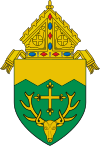Conversion of St. Paul Church

In 1893, the Conversion of St. Paul Roman Catholic Church was founded in Barton, Vermont, USA. The parish is under the guidance of the Roman Catholic Diocese of Burlington. The church is usually called St. Paul's by parishioners.
History
Rev. Joseph Turcot was the first resident pastor. He built a new church which was completed on May 24, 1903. Bishop John Michaud blessed the church, whose membership included 60 families and an average Sunday attendance of 300 people.[1]
In 1962, a parishioner erected a statue of Jesus overlooking Crystal Lake.[2]
In 2004, the church was merged into a parish with St. Theresa's in Orleans and St. John Vianney in Irasburg. The reconfigured parish was known as "Trinity Parish."
IN 2006 Fr. Rupp entered a demolition derby as part of fundraising activity to help send parish teachers on a trip to Rome.[3][4][5] A clip of the race was televised throughout the state on the evening news.
Missions and missionaries
The first Mass was said in Barton in 1851.[6] After 1854, priests from Stanstead and St. Johnsbury alternated saying mass in the area.[2]
Barton was a mission church of Newport after their parish was established in 1873. Mass was said in the Barton Academy hall until 1878. The parish bought a church from the Congregationalists who had built a new one.[1] Because the church had been converted to Catholic use, the official name the "Conversion of St. Paul" was thought appropriate.[7]
Just before their first priest arrived, the railroad came through. The company moved the church to East Street.[2]
The parish's first priest also said mass in Greensboro Bend twice a month for several years.
From 1918-2005, the pastor was mission pastor for St. John of the Cross in East Albany.[8]
About 2002, the parish priest became responsible for two more parishes, St. Teresa's in Orleans and St. John Vianney in Irasburg.
The school
Fr. Turcot established the parochial elementary school. The school opened in 1896 in a private home on May Pond Road.[1]
In 1896, the parish purchased an old store building to use as a school. This was moved near the church.[2]
Fr. Eugene Leblanc contracted with the Sisters of the Assumption of the Blessed Virgin Mary of Nicolet, Quebec to teach at the parochial school in 1907. Sister St. Benjamin arrived with three other nuns. School population was around 100 until 1917 when a fire destroyed the tub factory, forcing their employees to move elsewhere for work. The number of pupils plummeted to 55.
As French was the native language of the teaching nuns, and often, the mother tongue of the students, teaching French was often a major part of the curricula. In 1945, more time was devoted to English, then dropped entirely. In 1987, the school again taught French.
The parish built a new school and convent in the 1950s. In 1960, there was a record 194 students.[2]
In 1991, the Sisters of the Assumption withdrew from the school.
Enrollment in 1995, totaled 99.
In 1997, the diocese notified the school that it would cease subsidizing it and it would close its doors at the end of the school year. This was coincident with the withdrawal of the nuns that had taught there for ninety years. The congregation's support prevented this planned closing.[9]
Peter Close became principal in 2004. As of 2016 Joanne Beloin was principal.
Tuition for Catholics in 2006 was $1,350 to $2,000, which was the lowest tuition for any Catholic school in New England.[10]
In 2008, the school was accredited by the New England Association of Schools and Colleges.[11]
In 2010, authorized by the state to do so, the public Orleans Central Supervisory Union furnished an interventionist, part-time, at the school.[12]
Pastors
Pastors had assistant priests from about 1922-1970 (est.)
| Pastors of St. Paul | |
|---|---|
|
Footnotes
- ^ a b c Barton, Vermont - Schools & Community - Northeast Kingdom
- ^ a b c d e Young, Darlene (1998). A history of Barton Vermont. Crystal Lake Falls Historical Association.
- ^ Our Apologies Archived 2007-09-27 at the Wayback Machine
- ^ "Archived copy". Archived from the original on 2007-03-30. Retrieved 2007-06-28.
{{cite web}}: CS1 maint: archived copy as title (link) - ^ goliath.ecnext.com http://goliath.ecnext.com/coms2/gi_0199-5820598/Crashing-for-Christ-Jesus-Christ.html. Retrieved June 29, 2007.
{{cite web}}: Missing or empty|title=(help)Template:SemiBareRefNeedsTitle - ^ Catholic Church Records
- ^ St. Paul's Ladies Guild,Favorite Recipes, Trinity Parish, 2007
- ^ Daniels, Paul (2005). The Bell Tolls No More To Call the Faithful From Their Chore.
- ^ Schools Archives Archived September 27, 2007, at the Wayback Machine
- ^ [1][permanent dead link]
- ^ [2] Archived 2009-06-16 at the Wayback Machine
- ^ Creaser, Richard (September 22, 2010). "Hiring consolidation on the OCSU Board agenda". the Chronicle. Barton, Vermont. p. 11.
- ^ L.P. Sevigne (Administrator)1922
- ^ Obituary of Norman Nadeau retrieved July 2, 2008
External links
- Gelineau, Rev. Wilfrid A., Fifty Years at St. Paul's Church, Barton, Vermont 1902-1952, Gilpin, Hunt & Co. Inc., 1952
- Conversion of St. Paul Church website
- Official Diocesan maintained website
- St. Paul's School official website
- Listing of St. Paul's Cemetery

